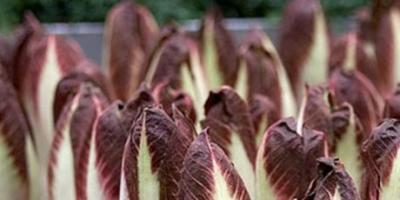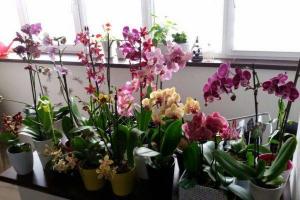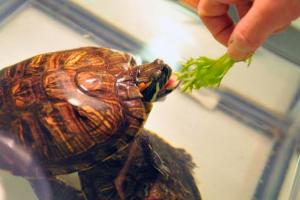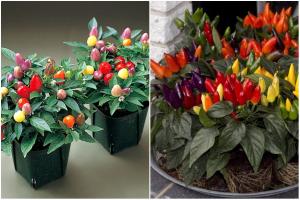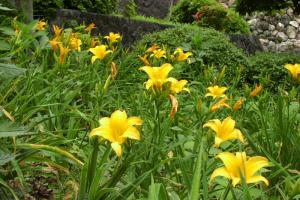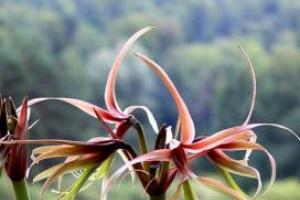Myrtle, which is easy to care for at home, is evergreen. In Mediterranean countries it is grown as a shrub or small tree, and in cold climates it has become a houseplant. Myrtle is often perceived as a gift for the bride, which foreshadows a successful marriage.
Types and varieties of flowers
Several types of myrtle are grown at home.
The most popular are:
- Common myrtle or indoor myrtle is the most common species. The trunk of the plant is not long, but well developed. The bark is peeling. Its color is red-brown. The small leathery leaves have a rich green hue with a very pleasant aroma.
- Tarentina is a compact shrub.
- Alhambra - forms fruits and berries and is distinguished by very dense green foliage;
- Variegata - the plant stands out among others with its very variegated foliage.
If desired, you can also find more exotic forms of myrtle on sale, but the most common ones are also very beautiful when grown correctly.
Myrtle - growing features
Myrtle is grown at home in two ways - from seeds or apical cuttings. Those plants that are commercially available are most often obtained by cuttings. At home, if you want to grow myrtle yourself, you can use both methods.
Using seeds

Propagation of myrtle by seeds is not the most effective, but it is still used by amateur gardeners. The seeds are planted in early spring in a pre-prepared light substrate, which is made up of peat and sand, taken in equal quantities. A 10 cm layer of soil is poured into the planting box. Next, seeds are sown on it and covered with 4 cm thick soil on top. After this, the soil is thoroughly moistened and the box is covered with glass. The seed germination temperature should not be lower than +20 degrees. To ventilate, the glass must be raised once a day for 4-5 minutes. Seeds germinate in about 2 weeks. If the seedlings are too dense, they are thinned out.
Plants dive when they have 3 leaves.
30 days after germination, the first fertilizing with nitrogen fertilizer in a weak concentration is carried out. Subsequent fertilizing is carried out once a month, alternating complex mineral fertilizing and organic fertilizer.
By cuttings
Cuttings allow you to get a new plant that will fully retain its parental properties. Cuttings can only be taken from healthy myrtle. You should not take shoots that are too young for them. Only semi-lignified shoots are used for cuttings. The cut, which is made at an angle of 45 degrees, is treated with root to stimulate the formation of roots. Afterwards, the cutting is placed in the soil, which must be constantly moist. When everything goes right, the cutting takes root and a new plant begins to develop. If you miss a moment and the soil in the pot dries out, the cuttings will not be able to put out roots, even after the soil moisture is restored. After rooting, care will be the same as for an adult plant.
Myrtle is the very plant that is recommended to be grown in every home. Its fragrance during flowering cannot be compared with anything, but beneficial features it simply cannot be overstated. Even the smallest plant is capable of protection environment in any room from pathogenic viruses, bacteria and microorganisms. Healing tinctures can be prepared from it; its aroma is used in cooking to give a unique taste to cape and fish.
In addition, a myrtle tree or shrub looks great in the design of rooms and office premises, decorators and landscape designers adore him. Let's take a closer look at this magnificent evergreen plant and try to understand what requirements the plant makes for the gardener.
The myrtle tree is a bright representative evergreen shrubs from the genus Myrtaceae, these plants grow in large numbers in Europe, North America, Asia, the Azores and the Caribbean archipelagos. If we literally translate the name into Greek, it reads as “balm”. In the groves of myrtle trees you experience the pleasure of the fragrant aroma, especially during flowering periods.

As for the description of culture, we can say the following:
- The leaves of the tree are dense with a slight shine, they are slightly pointed at one edge and seem to be attached to short petioles. If you look through the leaf into the light, you can see the glands passing through it, it is thanks to them that the aroma and essential oils.
- The flowers also have a strong scent, it can be white or pinkish in color and are most often located in peduncles or can be located alone, it depends on the plant variety.
- The fruits, in the form of black berries, are quite edible; tinctures, teas and spices are prepared from them for various dishes.
- The tree has a trunk that diverges into a lush crown of large quantity twigs. Of course, in the wild, the size of a myrtle tree or bush is much larger than what we see in flower shops.
What to do after purchasing a plant
We can say that caring for myrtle after purchasing it is quite simple, however, various incidents occur, such as the shedding of foliage or its wilting. Therefore, before buying myrtle, think about whether you are ready to create conditions suitable for its growth? And they must comply with certain rules. Myrtle really loves fresh air and a lot of open space and light, so if your home lacks these requirements, problems will most likely begin.
At different times of the year, myrtle requires different care, for example, in winter it is in a pronounced state of dormancy, therefore the air temperature should be appropriate, no higher than +10-12 degrees. But in the summer it will require fertilizing and irrigation and removal to the balcony. Some gardeners do not limit themselves to “walking” on the loggia, and plant a myrtle tree directly in open ground on personal plot. However, such a bold step requires special preparation of the soil and place.

After the plant “arrives” from the store, it is necessary to wait two weeks so that the plant can adapt to new conditions, and then transplant it into a new pot. If the purchase was made in winter, then it is better not to touch the plant until spring. The soil should be chosen as for azalea plants; it is best to take a ready-made one, it contains all the components necessary for normal plant growth.
How to care for myrtle at home
In order for a plant to feel “at home,” it needs to create optimal conditions.
Lighting
For myrtle, diffused light, albeit direct, is suitable sunlight will not cause him indignation. You just need to shade it slightly during too hot periods. Flowering will occur if the plant has enough light, otherwise you will not see a single flower stalk. The best direction in parts of the world will be east and west, so place the pot on these windowsills. Living in a north window, myrtle will not bloom and may become faded and lose its foliage. But for winter pastime, the northern direction is very suitable. After bringing him into the light, he will understand that it is time to awaken and quickly become more active about the “new” life.
Important! In winter, myrtle also needs light, but staying on a southern windowsill during hibernation is undesirable, since in this case the dormant period will be limited in time.
Do not allow a sudden change of habitat; it is better to do this gradually so that the plant does not experience stress and begin to shed its leaves.
Temperature
Temperature is very important, moderate heat is what is ideal for myrtle wood. In summer, no more than 20-21 degrees Celsius, and in winter it is better to lower the thermometer to +10 degrees or even less. If the winter temperature is right for the plant, it will thank you abundant flowering in summer. In order for wintering to be successful at home, abundant watering and moistening of the tree is necessary.
Do not allow the air to become dry, but even if the tree has lost its leaves and become bald, do not throw it away immediately; it can recover by spring and will completely restore its greenery. Continue to water it a little, but regularly, and its strength will gradually return, but flowering will have to wait until next year.
Humidity and watering
Spraying is carried out constantly, especially on hot and dry days. Only in winter, at a maintained temperature of less than +10 degrees, spraying should not be done. At a time when the plant is actively growing greenery and preparing for flowering, it especially needs wet procedures.
In spring and summer, watering is carried out constantly, but after it has dried out upper layer soil. In winter, water the plant much less frequently; it is advisable that soft and warm water. Make sure that, regardless of the time of year and state of activity, the soil is moistened; if you miss the moment and dry it out, the myrtle will become sick from lack of moisture and will begin to turn pale and lose leaves.
Avoid overwatering as this can lead to the development of fungal diseases and pests.
How to prepare soil for myrtle
As mentioned above, soil can be purchased at finished form, but it’s not difficult to prepare it yourself. To do this, you need to take turf soil, humus peat substrate, sand in the following proportions: 1:1:1:0.5. Such an optimal mixture of components will allow the plant to receive all the necessary nutrients.
Top dressing
During the period of rapid growth from spring to autumn, myrtle needs weekly feeding. However, there are several directions here, they depend on what exactly you want to get from the plant. If it is important to you that the myrtle blooms, then use nutrient supplements with a high phosphorus content, and for those who dream of miniature myrtle, it is better to use nitrogen-based fertilizers. For all other green lovers, we can recommend complex fertilizer in liquid form, which is produced specifically for decorative deciduous crops.
Transplanting, pruning and shaping a tree
There are special requirements for different ages of myrtle. For example, for an adult plant, replanting is required no more than once every four years, but for young plants it is best to replant every year in the spring before the first flowering.
Make sure that when planting in a new place, the myrtle is not too deep. The root collar should be level with the ground. A drainage layer of expanded clay should be placed at the bottom of the container, and the plant should be transferred along with the earthen lump.
Do not replant myrtle in a very large pot; its crown can serve as a parameter. The capacity should not exceed its crown, but on the contrary, be almost half as much.
For greater density, the myrtle is pinched and thereby stimulates the development of new shoots. This procedure is best carried out in the spring, although pinching can be done at any time. Myrtle lends itself perfectly to shaping; the most intricate figures can be made from it, which is what landscape artists do with success, but in this case, you should forget about the flowering of the plant.
The plant is easily propagated by cuttings and seeds. For the first option, cuttings of no more than 7 cm are prepared, after treatment in a growth stimulator, they are planted in the ground under cover. Seed material, previously soaked in the same solution, can be planted in the soil and covered. After cuttings, flowering occurs in the 4th year, and when propagated by seeds, a little later.

The main pests are aphids and scale insects, and also, if the air is dry, spider mites.
- When appearing on leaves dark spots, know that this is the machinations of the scale insect, here you can try a soap solution or any of the insecticides.
- Aphids are sucking insects that often sit on the bottom of leaves, which causes them to curl and dry out. Only a strong insecticide can help cope with it, and several treatments will be required.
- Spider mites are characterized by cobwebs on branches and trunks, and are also destroyed with the help of insecticidal preparations.
Myrtle is a wonderful plant that will delight you with its bright foliage, exquisite aroma and the healing properties of its secret properties.
It's small evergreen tree native to the Mediterranean and North Africa. The ancient Greeks and Romans associated myrtle bonsai with love, and in Europe today myrtle flowers are often found in wedding bouquets. Because of its beauty, vigorous growth, and tolerance to pruning, the ancient Romans used myrtle extensively for typing. The myrtle tree is excellent options For .
Small oval leaves, rich green tint and aroma. Fragrant flowers appear in late summer and then black and white edible berries. They are used in the brewing of aromatic liqueur in Sardinia and Corsica. Myrtle is a heat-loving plant and requires long, hot summers to produce flowers.
Bonsai from:

The formation of myrtle bonsai is best done during the growing season. While some of these trees can grow up to 30 meters, quite a few are only 3 meters tall. Most of them grow as small trees or large shrubs.
Mail and feeding
Well-draining soil that does not retain moisture is ideal, but active growth organic matter will be needed (about 40%, compost bark - a good choice). This stimulates the plant's flower growth in summer and leaf growth in spring. This does not prevent you from adding compost manure to the soil.
It is necessary to add every two weeks in spring and autumn. Try alternating common herbal products and specialized for bonsai.
It's best when the temperature reaches about 50 degrees at night.
Try to maintain consistency in watering and lighting, as a constantly changing situation may result in a concomitant slowdown in growth.
Forming a bonsai from myrtle
Miniature myrtle is quite easy to form. It suits many styles perfectly:
- formal vertical informal vertical;
- cascade and semi-cascade;
- rock root and group plantings.
The formation of myrtle bonsai is best done during the growing season. Start pruning your bonsai at the end of the summer season. This will promote bud development next year. 
Sharp pruning of the top of the tree will help make the trunk thicker. Thus, you yourself choose the shape and style of the tree.
Pruning the trunk greatly affects the flowering of buds. For the most part, they respond well to pruning, but do it during the fall season because it can encourage buds for the following year. You can sacrifice flowers to form a crown, but only temporarily.
To change the direction of branching, use a wire:
- Press down the branch with thread or wire as much as necessary;
- Tie, starting from the trunk and ending with the required branch, with wire and bend it. If the branch is not fixed in the shape we need, use a tighter wire.
Myrtle(Myrtus, Myrtle tree) belongs to the Myrtaceae family and unites more than 40 species of evergreen woody shrubs with dense branching. The special distinctive quality of this plant is high content beneficial essential oils in fruits and leaves with small black dots on the underside of the plate. But lovers indoor plants Myrtle is valued for its ability to form a very beautiful miniature tree from a lush shrub (including bonsai with almost any crown shape).
Caring for this miniature tree at home does not cause any particular difficulties even for novice gardeners, if you follow enough instructions. simple rules and trim branching shoots in time. Photo indoor species and varieties of myrtle, as well as tips on home care for the plant, you will find later in this article. Growing a myrtle tree can be compared in terms of complexity to caring for such popular indoor plants as ficus benjaminata, dracaena marginata, house yucca, crassula money tree, zamioculcas dollar tree, chamedorea palm, decorative deciduous monstera.
The aroma and beneficial properties of essential oil from myrtle leaves have been used by people for hundreds of years. In addition, “liquid incense” and “myrrh” have been used since ancient times as cult attributes in various religious events by ministers of many well-known concessions. Some modern skin care cosmetics contain myrtle oil, which contains: useful material, such as myrtilin, camphein, amino acids, camphor, cineole. Many pharmaceutical companies also widely use myrtle oil to make effective medical supplies. For example, the beneficial substances of myrtle promote rapid recovery and the formation of bone tissue.
ethnoscience has also long and successfully used fruits, flowers, myrtle leaves for making medicinal tinctures, ointments and decoctions. You can add the flowers of this plant to black tea to restore intestinal function. An infusion of fruits restores skin covering scalp and strengthens hair follicles. A decoction of the leaves can quickly cure even a purulent sore throat (Pour 200 ml of boiling water over a teaspoon of myrtle, leave, cool and pass through gauze. Gargle the sore throat 2-3 times a day). Some gardeners grow myrtle exclusively as a medicinal remedy, along with medicinal Kalanchoe.
Since ancient times, the myrtle tree has been considered a symbol of kindness and mercy, and also personifies peace, silence and inner harmony. Previously, village girls gladly wove lush wreaths from myrtle branches to decorate the bride's beautiful hairstyle, as well as to decorate a wedding event. But even today the symbolic meaning of myrtle has not lost its relevance. If single women are given spathiphyllum Female happiness, and men are given anthurium Male happiness, then you can give happy newlyweds a beautifully decorated myrtle tree as a wedding gift, which is a symbol of a successful marriage and family well-being. Bridal bouquet given during a formal wedding, and the tree can be presented to the bride after the wedding events. By the way, myrtle will look great in any floral arrangement. Experienced phytodesigners interestingly place such flowering indoor plants as phalaenopsis or dendrobium orchids, geranium pelargonium, Saintpaulia violets with bright flowers, tuberous begonia, home impatiens, hydrangea and gerbera against the background of miniature trees.
At home, common myrtle (Myrtus communis) is usually grown, the height of which reaches 40-80 cm, depending on the variety. Caring for this indoor tree is not at all difficult. The medium-sized shiny leaves of this evergreen plant grow on short petioles and have an elongated ovoid shape, pointed at the end. The flowering period at home can occur only after 4-5 years from the moment of planting. Single flowers white with a pinkish tint can be either simple or terry. Myrtle fruits are dark blue berries. With the help of timely pruning, you can form the desired appearance of the trunk and crown of the common myrtle.

- photo: myrtle tree flower
If you want to form a nice tree in the bonsai style from a woody shrub, then start shortening the shoots by pruning to stimulate growth in thickness after the myrtle reaches a height of 30 cm. Taking into account the position of the shoots in the crown, we leave from one to five pairs of leaves after pruning. Since young shoots often grow straight upward, to form the desired shape crowns, you can use thin wire. And by fixing with tension devices, you can adjust the direction of old and thick branches. We can recommend that novice florists grow their first bonsai tree from unpretentious myrtle or indoor shefflera. A blooming bonsai made from Chinese rose hibiscus, azalea or fuchsia looks more impressive, but caring for these indoor plants at home is somewhat more difficult.

- photo: myrtle bonsai
♦ WHAT IS IMPORTANT!
Location and lighting.
The myrtle tree can be placed on a rack with shelves or on a stand next to a window on the west or east side of the room. But the most suitable location for this plant is next to a window on the south side, since myrtle is a light-loving indoor plant. On sunny spring and summer days, be sure to shade window glass so that direct sunlight does not fall on the leaves of the tree, which can lead to yellowing and dropping of leaves.
Temperature regime.
The optimal temperature in the spring-summer season is 18-25°C. Ventilate the room more often and protect myrtle from strong temperature changes during the day. To improve the decorative value of the plant, it is advisable to keep the tree in winter at a temperature of 7-10°C. If possible, take the pot with the myrtle tree to an unheated place. glass balcony or loggia.
Air humidity.
Myrtle feels comfortable at high humidity levels (more than 60%). In spring and summer, you can place a container of water next to the pot, and the pot itself on a tray with wet expanded clay. On hot days, try to spray the tree with warm, settled water as often as possible. If during heating season If the plant is indoors, spray it with water daily.
Watering.
Water for irrigation is soft, warm and left to stand for several days. On hot summer days, water the soil deeply several times a week. The substrate must be constantly moistened, but without stagnation of moisture at the level of the root system. In autumn and winter, watering should be moderate - once a week with a short period of soil drying between waterings. But if the soil dries out for a long time, the leaves of the myrtle tree turn yellow and fall off.
Earth mixture and fertilizing.
How to prepare an earthen mixture yourself? Take equal parts of garden soil, peat and perlite, mix thoroughly. Instead of perlite and peat, you can use clean river sand and leaf soil.
Fertilizing should be done once a week in spring and summer. You can use complex organic fertilizers for flowering indoor plants without lime. In autumn and winter, fertilizers should be applied no more than once a month.
Transfer.
Until 3 summer age Myrtle should be replanted annually in October-November. For replanting, choose a deep pot 3 cm wider than the old one, on the bottom of which you need to pour a drainage layer with expanded clay. Do not bury the root collar during replanting. An adult myrtle tree is replanted once every 2-3 years, when the earthen ball is strongly intertwined with the roots of the plant.

Reproduction.
At home, you can propagate myrtle by seeds or by cuttings.
Seeds. Pour a mixture of peat and sand into the container, sow the seeds and sprinkle a little of the same substrate on top. For supporting high level humidity and optimal temperature cover the container with a plastic bag and spray the substrate daily. Lighting - diffused. Sprouts appear after a month. Sprouted seedlings are pinched at the required height to make it easier to form the crown of the tree in the future.
Cuttings. A 9 cm cutting must be cut from a side shoot. The cut site can be treated with a root formation stimulator and the lower leaves must be removed. To root, we deepen the cuttings into a mixture of peat and sand, and cover the container with transparent film. It is important that the substrate temperature does not fall below 25°C. Water the soil regularly and after a few weeks the cuttings should take root completely.
The plant, which came to us from ancient antiquity, brings peace, tranquility and comfort to the house. Myrtle is a resident of the Mediterranean, where in nature it reaches a height of 3-5 meters. In the cultivated version, it is a small tree up to 1 m high.
As an ornamental plant, it dates back more than 400 years. They can decorate your home, office and winter Garden. Myrtle has amazing healing and disinfecting properties. Various infusions are prepared from it; its leaves have a great ability to purify the air. In a word, myrtle not only decorates the house, but also brings undoubted benefits.
The main feature of myrtle cultivation is the need cold wintering. As a southern resident, he loves light and high humidity. Myrtle – flowering plant. For good flowering it needs pinching. On the other hand, if you actively shape its crown, its ability to flower may suffer. Therefore, you need to know the basic rules of pruning and decide what you like more – a flowering tree or a plant with a beautifully formed crown.
Another feature of myrtle is its slow growth. Over the course of a year, the tree gains only 10-15 cm.
Myrtle is not very whimsical and not difficult to care for. It is enough to provide it with temperature, light and watering conditions.
Planting an indoor myrtle flower
Landing this home flower has no special features. Transplantation is carried out as the plant grows. Each time they take a flower pot bigger size.
Planting methods
Myrtle propagates by cuttings or seeds.
Optimal time for planting
The most best time for planting cuttings in winter - February, in summer - July. For propagation by seeds, the time of year does not matter.
Soil for the plant (Composition and selection of soil)
The following soil composition is suitable for myrtle:
- A mixture of turf, humus, peat and sand in equal parts
- Greenhouse land
- Peat, humus and sand in a ratio of 1:1:0.5, respectively.
The soil should be slightly acidic.
Features of caring for your home myrtle flower at home
There is no difficulty in caring for myrtle if you follow the basic conditions for its cultivation.

Myrtle grows well in bright light. However, in extreme heat, he needs openwork shade. If the myrtle lives in the country in the summer, it is better to place it in the shade of trees at midday; if on the balcony, you can shade it with a tulle curtain.
In accordance with this, you need to choose a place in the house. It is better if it is south, south-east or south-west. If you put it on the north side, it will, of course, survive, but it will bloom worse.
Important! If the myrtle is on the north side, the rest period lasts 3 months, and if on the south it is reduced to one and a half months.
Air humidity
Myrtle loves moist air, especially in summer. The soil should not dry out, and the plant itself must be sprayed.
In winter, if it is not possible to keep the myrtle in the cold, it should be placed away from heating radiators and maintain high air humidity.
Important! Do not forget to ventilate the room where the myrtle lives.
Temperature regime for the plant
The main difficulty in keeping myrtle in good shape is organizing proper wintering. Myrtle urgently needs a fairly low temperature in winter - optimally no higher than +7 degrees, in summer - +22 - +25 degrees.
How to water correctly
Overwatering and excessive dryness are equally harmful to myrtle. Intensified watering is carried out from spring to late summer. Then it is reduced to 1 time per week. It is unacceptable for the earthen clod to dry out. If there is water in the pan after watering, it must be drained.
Feeding and fertilizing the myrtle flower
You can feed myrtle all year round, only the frequency of fertilizer application changes.
In summer this can be done weekly, in winter - monthly. Fertilizers for flowering plants are ideal for feeding.
Trimming

Regular pruning of myrtle stimulates the growth of side shoots. If you do not do this, it is impossible to get a lush crown. Frequent pruning of young shoots can negatively affect flowering.
Trimming methods
To get a neat crown of the desired shape, you will have to come to terms with the fact that the plant will bloom less.
If you pinch the top, you will get a neat bush; if you do not touch the plant, the crown will be pyramidal in shape; if you trim it side shoots, you get a crown like a tree.
Transplanting myrtle
Young plants are replanted once a year, adults - once every 2-3 years.
Transplant methods
Replanting is done by simply transferring the plant into a new, larger pot. Naturally, in new soil. In order for the plant to be easily removed from the pot, you need to dry the earthen ball a little, so you should stop watering a few days before replanting.
Be sure to put drainage at the bottom of the pot, then plant the myrtle in soil of any composition indicated above. The soil needs to be well compacted around the plant. There is no need to bury the trunk into the ground.
Important! After transplanting, the myrtle must be watered well so that the water begins to flow out of the drainage hole of the pot.

Myrtle is propagated by cuttings and seeds. Both methods give good results and are not particularly difficult to do at home.
Reproduction methods
Cuttings
Cuttings can be taken both from a side shoot and from the main one, but not from the flowering one. From a side shoot you need to take a cutting no more than 10 cm, from the main shoot - 5-7 cm. Before planting, you need to remove the lower leaves from the cutting and trim the upper ones. Treat the cutting itself with root or heteroauxin. Plant in a flat tray in a mixture of leaf soil and coarse sand.
It is better to place the tray with cuttings in a cool, shaded place and cover it with film. As well as mature plant, seedlings need to be watered and sprayed. From time to time it is advisable to ventilate the greenhouse so that the soil does not become sour and the cuttings do not rot. Rooting occurs within a month. Then the grown plants are planted in separate pots in a regular myrtle substrate.
Important! If it seems to you that the myrtle is not growing, there is no need to worry, this is a temporary phenomenon for it. Cuttings may slow down their growth for a while.
Propagation by seeds
To sow seeds, take peat soil mixed with sand. Before sowing seeds, the soil must be moistened, possibly with a fungicide solution. Seeds are distributed into a tray on a layer of soil, then they are sprinkled with another layer of soil and covered with film or glass. The greenhouse needs to be ventilated and the soil should always be kept slightly moist. Seeds germinate on the seventh or tenth day. After the first leaves appear, the seedlings need to be transplanted into pots. When the root system develops and entangles the earthen ball, the plants are replanted again by transferring them into larger containers. Next, they need to be cared for like adult plants.
Bloom

If you want myrtle to bloom, you don't need to prune it in the spring.
When the plant blooms (flowering period), flower shape
Flowering period is June and July. At this time, the flower requires increased watering and fresh air. Some gardeners take myrtle to the dacha and dig the pot into the garden bed so that it is not exposed to direct sunlight, but has enough light.
Myrtle flowers are small, delicate, white or Pink colour. The main part of the flowers is located on the upper part of the crown. They come in regular and terry types.
Plant care after flowering
After flowering ends, watering and fertilizing are gradually reduced. In autumn the crown is pruned.
Important! If you keep myrtle indoors in the summer, it may not bloom.
Problems, diseases and pests of a flower
If myrtle is cared for well, it will not face any trouble. It can only suffer from overwatering, then the roots begin to rot and the plant dies.
If the indoor air is too dry, myrtle may become susceptible to pests. It is affected by aphids, scale insects and spider mites.
- Scale insects or shield aphids attack leaves and stems. Measures to combat it are spraying with a soap and tobacco solution with the addition of kerosene. The pests themselves are removed with a damp swab, and spraying with an insecticide saves from the larvae.
- Spider mites appear if the indoor air is too dry. You can get rid of it by washing the leaves (their undersides) soap solution or weak tobacco infusion. Insecticides can be used.
- Aphids attack leaves– they begin to curl and dry out. Treated with insecticides.
Important! Pests often attack older plants.
Plant species
As ornamental plant Myrtle is represented by only one species - the common myrtle (Myrtus communis).
There are practically no difficulties in growing myrtle. But we dare to give some advice.
- Annual replanting of adult myrtle is not required, but you can change the top layer of soil every year with the addition of complex fertilizers
- If you spray myrtle in winter, it may lose its leaves.
- Place myrtle in a child's room - it creates a very good atmosphere.
Answers to readers' questions

Myrtle is a perennial plant, with good care lives long.
Is it possible to keep this plant at home?
Myrtle in the house is a source of peace and good mood. Myrtle leaves contain essential oils that have a beneficial effect on mood and health.
Is this flower poisonous?
Myrtle leaves are (slightly) poisonous. May cause nausea and headaches in allergy sufferers
Why doesn't the flower bloom?
There may be no flowering if the crown is formed. It will not bloom even if it is kept indoors in the summer.
Why do the leaves turn yellow (dry)?
Myrtle leaves turn yellow if it is damaged by a pest. Dry air and lack of light can also be the reason for this.
Why does myrtle shed its leaves?
Leaves fall due to lack of light or too high temperature.
Flower care in winter
IN winter time Myrtle has a dormant period. It requires low temperatures, minimal watering and no feeding.

